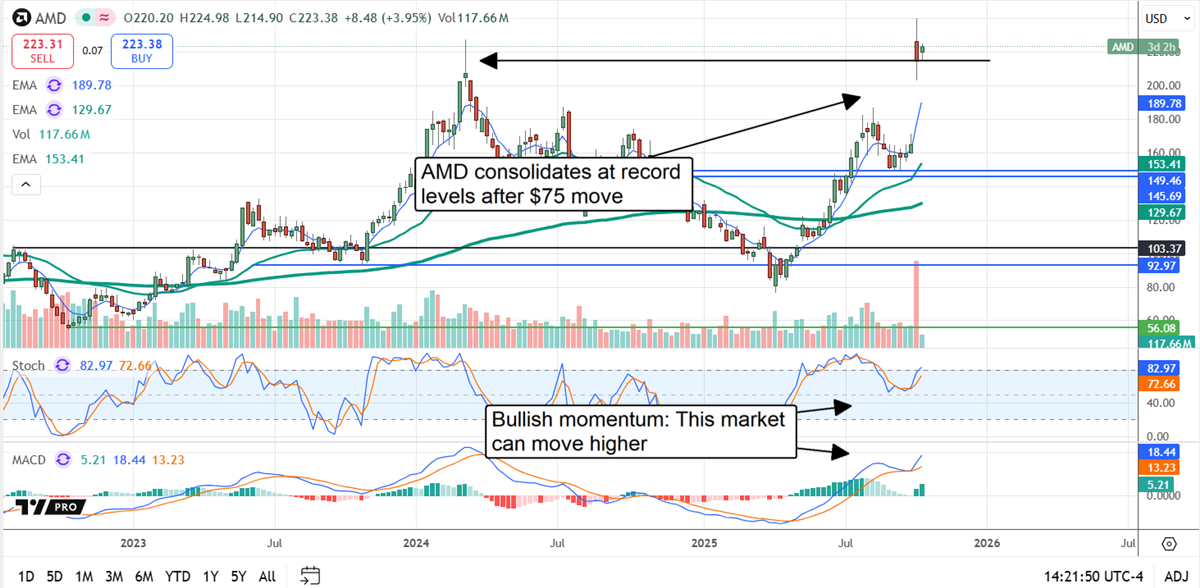’ stock price outlook, long tied to a forecast of GPU market-share gains, was affirmed by OpenAI and accelerated by . Oracle plans to deploy 50,000 Advanced Micro Devices’ MI450 line of AI accelerators in the third quarter of 2026.
While a drop in the bucket compared to OpenAI’s plans, Oracle will likely expand its plans, build more AMD-powered data centers, and drive demand for this business.
The critical takeaway is the quickness with which Oracle followed up on the OpenAI news. Because Advanced Micro Devices GPUs provide superior performance at lower cost, offer greater memory capacity, and excel for inference, AMD chips are an attractive alternative for hyperscalers.
Based on the supply-demand dynamic reported by Wedbush, it isn’t a matter of Advanced Micro Devices taking share from so much as meeting unfilled demand.
Investors should expect the remaining hyperscalers to follow suit, amplifying AMD’s revenue growth outlook with each announcement.
The figures are hard to pin down, but it is accepted that hyperscalers, including Amazon’s AMZN Web Services, Alphabet, and Microsoft, are already using several gigawatts of power across each of their data center networks. Demand trends suggest these networks will double in size—three times over—over the coming decade, and AMD chips will be at the core of that growth.
In this scenario, demand from the commercial hyperscale sector could more than quadruple OpenAI’s revenue over the next five years, adding as much as $500 billion to the revenue outlook.
Revenue forecasts are rising in October, but the consensus expects only $355.5 billion for the 2026 to 2030 period.
Analysts Like What They See in AMD’s Product Pipeline
The analysts’ response to the news is favorable, with them increasing the coverage, upgrading the stock, and raising their price targets in the wake of the OpenAI news. The chatter indicates that the shift to rack-scale capability is a game-changing event that will be highly accretive to the business.
The data tracked by MarketBeat shows 40 analysts rating the stock as a Moderate Buy, with the number of ratings up by 25% over the preceding 12 months and sentiment firming. Recent revisions include upgrades to Buy from Moderate Buy equivalents, putting the bias at 70% in favor of an outright Buy, and price targets that point to the $300 level.
 A move to $300 is likely as it aligns with the technical outlook. The OpenAI announcement catalyzed a 30% increase in AMD’s stock price, which is likely only the first half of the move. The market for AMD stock is struggling with resistance at the prior all-time high but consolidating well above support targets, with convergent MACD and a bullish signal in the stochastic.
A move to $300 is likely as it aligns with the technical outlook. The OpenAI announcement catalyzed a 30% increase in AMD’s stock price, which is likely only the first half of the move. The market for AMD stock is struggling with resistance at the prior all-time high but consolidating well above support targets, with convergent MACD and a bullish signal in the stochastic.
The stochastic is a critical factor, as it is low enough to indicate this market has ample room to move higher.
The catalyst for this move may come with the Q3 earnings report. While the results are likely to be good, with the company outperforming the consensus for a 28% year-over-year revenue increase, the guidance will move the market.
It will likely include deal news and updates on the MI450 lineup, affirming the hypergrowth outlook.
Cash Pile to Swell—Good News for Investors
Cash flow is a key factor affecting NVIDIA’s stock price—and will soon impact AMD’s as well. While growth is strong, cash flow remains important. NVIDIA’s increased cash flow from AI has enabled substantial investments in AI and future expansion, while also building a large cash reserve.
NVIDIA is now a net-cash business relative to its total liabilities: AMD is on the cusp of a similar event that will drive significant value for its shareholders. Although AMD’s stock trades at a premium in 2025, it continues to offer value for long-term investors.
The 55x price multiple in 2025 falls to only 10x by 2035, potentially lower due to overly cautious forecasts. This suggests that AMD’s stock price could rise by 100% to 200% within the next two to five years (probably sooner).